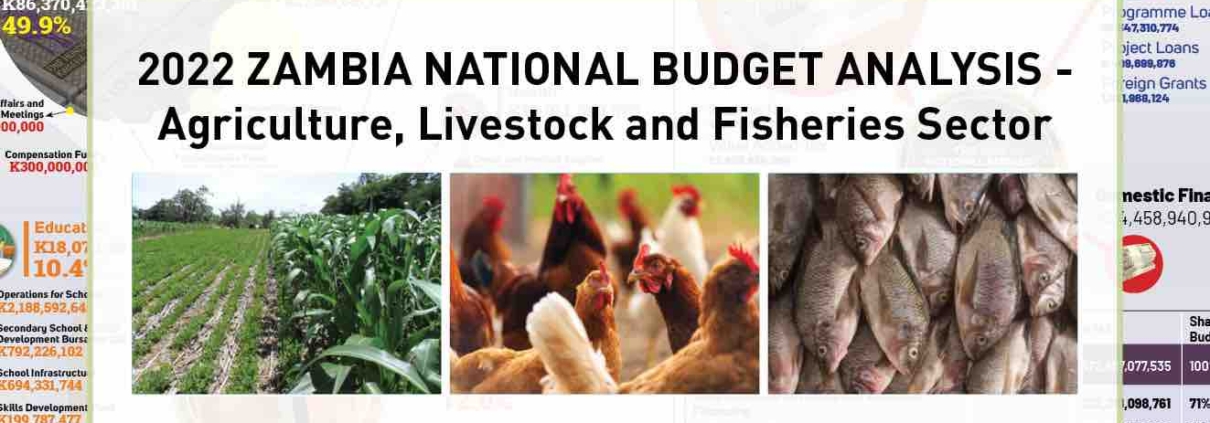Zambia has immense potential for agricultural development given the favourable agro-climatic conditions, which are suitable for production of a diverse variety of crops and livestock in nearly all parts of the country.
However the sector’s contribution to GDP has been unstable and declining in the recent past to around 2-3% with relative decline in the last few years (15.60% in 2010 to 2.73% in 2019 (Source: World Bank, 2020)
According to Mulenga et al., 2020 in the Agricultural Status Report, the decline and contraction in agricultural output could be attributed to high precipitation variability which affected rain-fed production systems especially smallholder farmers.
However recently the sector has shown positive improvements due to the good rainfall distribution and bumper harvests.
The agriculture share of the budget has for many years failed to meet the Maputo declaration where African states are to allocate a minimum of 10% of the national budget to help achieve the 6% annual growth rate. This year, the allocation to the Farmers Input Support Programme (FISP) and strategic food reserves in the 2022 budget are K5.4 billion and K960 million compared to K5.7 billion and K517 million allocated in the 2021 budget respectively. The allocation to FISP is down by K3 million in 2022 compared to the 2021 budget while there is a notable increase in the allocation to strategic food reserves (FRA) by K443 million.
These changes in allocation especially on FISP has negative consequences in terms of increasing production and productivity unless prudence in the implementation of the programme is followed. Government announced a new comprehensive support program for the Agriculture sector, which commences in the 2022 – 2023 farming season. As PMRC we note that for this programme to be successful, an all encompassing and comprehensive review of E-voucher (E-FISP) and Direct Input Supply (DIS) will be required for FISP by key stakeholders to arrive at the best mode programme delivery.
Previous studies have shown that if well implemented E-FISP has the ability to enable Government reduce the stress on the treasury as this removes corruption, racketeering, administrative costs and transportation costs (Baltzer & Hansen, 2012). Operating the Direct Input Supply (DIS) system will require improving monitoring systems and enhancing transparency to ensure quality inputs with improved targeting of eligible beneficiaries.
The 2022 budget focuses on addressing the problems of low production and productivity, limited agricultural market, underdeveloped value chains and the reliance on rain-fed agriculture taking into account the effects of climate change and variability. The budget commits to increasing production and productivity by the development of farm blocks, irrigation infrastructure and agricultural mechanization.
These measures are capable of supporting crop diversification and increase the output in the sector if implemented as planned.
Notably the 2022 budget has seen great increase in the funding of research and development under the Ministry of Agriculture from K5, 957,500 in 2021 to K25, 146,955, although timely disbursement of allocated funds will be critical in realising research impacts on productivity.
Another notable feature of the budget is Government’s commitment to recruit more livestock extension officers to enhance the provision of services to livestock farmers as well as empower youths and female-headed households through livestock stocking and re-stocking as well as support for livestock infrastructure, however there is no indication on the number of personnel to be recruited. In addition, the budget presents a significant increase in allocation to livestock disease control from K2, 825,000 in 2021 budget to K96, 398,266 in the 2022 budget, and this will effectively combat major livestock diseases across the country to enhance productivity in the livestock sub-sector.
The fisheries sub-sector, produced 94,943 and 45,670 metric tonnes from our natural water bodies and under aquaculture in 2020 respectively. During the same period, the country imported an estimated 80,000 metric tonnes of fish. The sub-sector has potential to meet domestic demand, penetrate regional export markets and contribute significantly towards job creation. It is therefore critical that the subsector be adequately supported to increase its output. Enforcement measures such as fishing ban ought to be strengthened in the water bodies to allow for fish breeding. Additionally, there is still room to increase the activity in aquaculture hence the need for more support to supplement the efforts and strides scored by Zambia Aquaculture Enterprise Development (ZAEDP) especially that funding to the fisheries production and productivity improvement programmes allocation has reduced drastically from K397, 170, 248 to K139, 605,511.
PMRC notes that in order to increase the output in the Agriculture sector, we need to urgently address challenges of climate change and variability in order to improve production and productivity in the sector. PMRC commends Government on the proposed measures and proposes the following:
Recommendations
- In the face of climate change, Government is urged to reduce dependence on rain-fed agriculture by ensuring the expansion of irrigational infrastructure and facilitate concessional finance to propel crop diversification.
- Government is encouraged to re-consider the position taken on e-Voucher and improve the system at all levels of implementation to enhance efficiency in the delivery of inputs as it has proved to be a better option in comparison to Direct Input Supply (DIS) if well implemented, it will allow Government to save resources. These measures must be considered as Government embarks on the development of a New Comprehensive Support Programme to be implemented in the 2022-2023 agricultural farming season.
- In the aquaculture subsector, there is need to provide additional funding for the establishment of additional aquaculture parks as well as research and development to increase in fish production in order to meet the country’s fish local demand and export market.
- In order to grow and boost the country’s export potential, Government is urged to focus on diversifying away from maize, towards more value addition centered agricultural output especially that the country is well positioned regionally to maximise benefits from the export of diverse value added agricultural goods.




